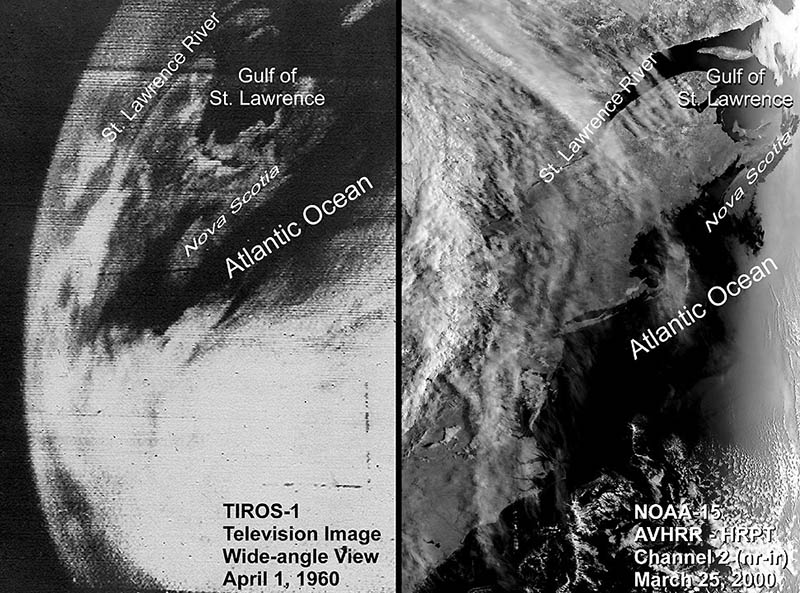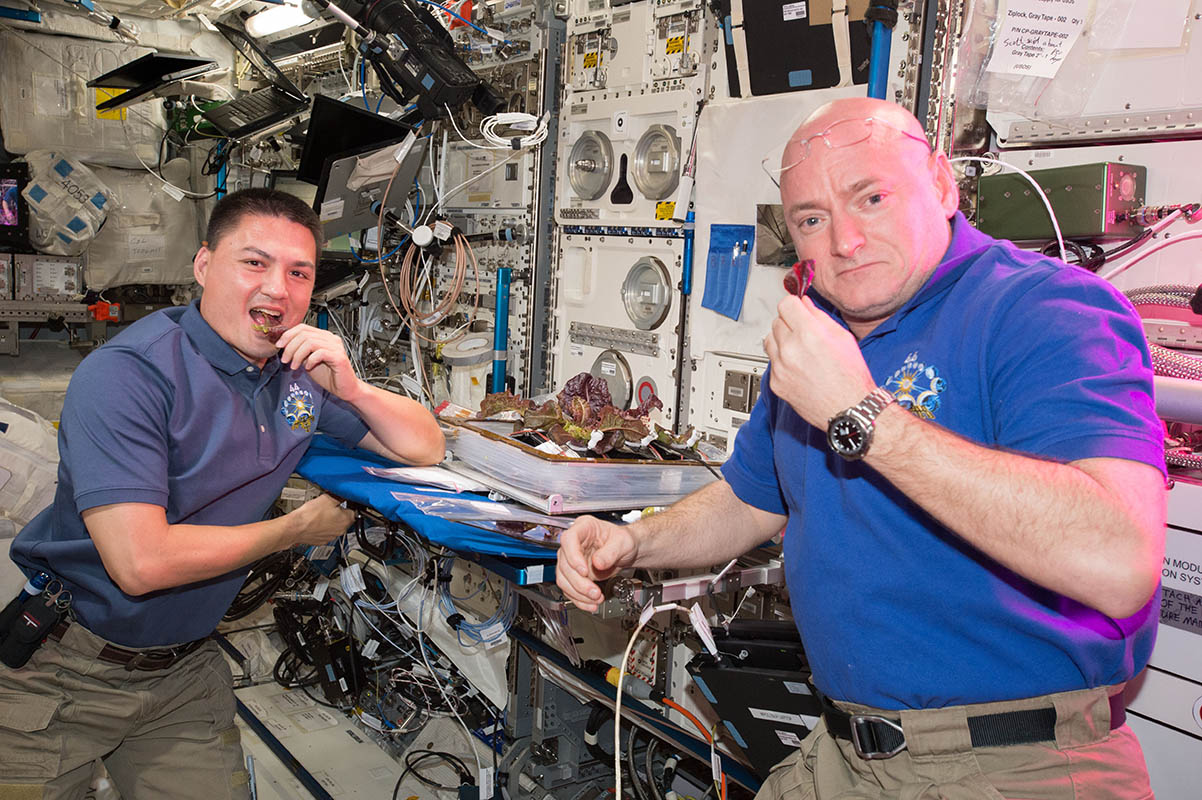13 December 2015 || 11 minute read
Title image is Expedition 45/46 crew Tim Kopra, Yuri Malenchenko and Tim Peake in front of Soyuz simulator. Credit: UKSA-M. Alexander
On 12 April 1961 Major Yuri Gagarin became the first human to orbit the Earth. Since then a further 532 people have done so. This week, almost 55 years later the first British European Space Agency (ESA) astronaut, Tim Peake, becomes the 533 person to do so.
In 2012 it was announced that the UK had made a “one-off” payment to ESA’s human spaceflight programme of €20 million, plus a further payment of €16 million to related human spaceflight activities over a four year period to secure Tim Peake’s flight to the space station. In return for this payment UK industry would gain access to contracts for the development of the European Service Module of NASA’s new Orion module, which Europe is developing in a barter agreement with the USA.
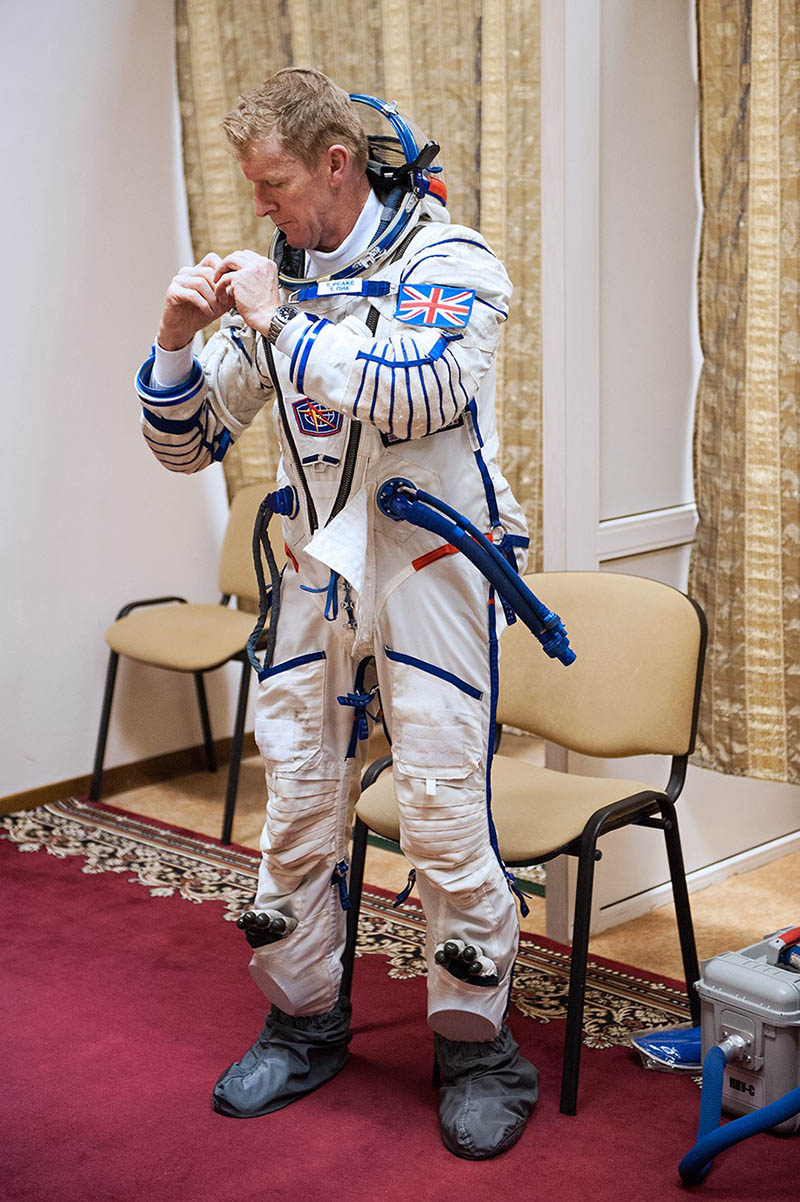 Tim Peake dressing up in the Sokol suit for Soyuz exams at Star City. Credits: UKSA-M. Alexander
Tim Peake dressing up in the Sokol suit for Soyuz exams at Star City. Credits: UKSA-M. Alexander
In 2014 the UK made a further one-off payment of approximately €70 million to the space station programme. Thus actually securing Tim Peake’s flight to the space station.
Exploration is a cultural phenomenon that has been shaped over millennia. Exploration is done by humans. Explorers are brave idols, gaining fame and endorsed by royalty. Explorers return with treasure and tales of the amazing. Exploration creates wealth. So why should space be any different?
In recent decades exploration has become increasingly robotic with the emergence of remotely piloted and even autonomous aerial, underwater, and of course, space vehicles. Spaceflight has spanned this transition. So, with the UK spending almost €90 million for Tim Peake’s stay on the International Space Station it seem reasonable to ask what the point of human spaceflight is today.
We can describe the evolution of robotic spaceflight through three key phases, from pioneering engineering, to sustained mastery, and finally to diminishing returns.
In the late 19th century pioneers like Tsiolkovsky, who became known as the Father of Cosmonautics, start to think about space travel. Shortly afterwards engineers like Goddard, Oberth, and van Braun started to experiment with rockets. This is the start of the pioneering engineering phase, which continued through to the start of the Space Age and the launch of the 1st spacecraft, Sputnik-1, and the numerous firsts that followed it.
The pioneering engineering phase was over by the mid-1960’s, when we were able to not only launch spacecraft but place them into orbits that best suited our need.
Since the mid-1960’s we have been seeking sustained mastery of robotic spacecraft. For example, with direct-to-home television services and sustained solar system exploration. We have established an equivalent of our terrestrial utilities in orbit, with spacecraft providing communication and navigation services to other spacecraft.
By August 1989 we had sent a spacecraft to every planet in the solar system. We have since changed the definition of a planet to make this true, but in July of this year we finally sent a spacecraft past Pluto . In July 1997 we landed our first rover on Mars, and in March 2011 we put a spacecraft into orbit around Mercury — an immensely challenging engineering feat.
At some point within the last decade, I would argue, we achieved sustained mastery of robotic spaceflight. Putting a spacecraft into orbit around Mercury and landing Philae on a comet must be accepted as evidence that, if we choose to, we can put a spacecraft anywhere we want within our solar system. Indeed, as if to prove how accessible space has become in November 2013 an American high school launch the first spacecraft designed, built and now operated by school children.
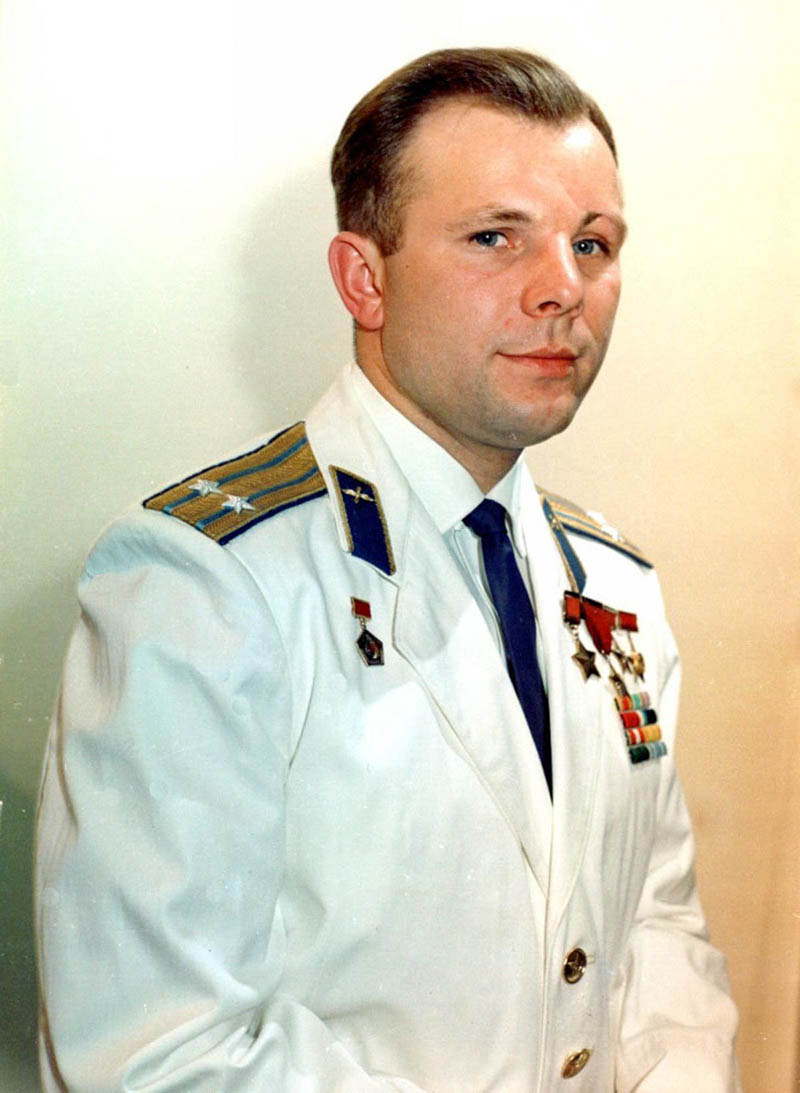 Yuri Alekseyevich Gagarin: Ю́рий Алексе́евич Гага́рин (9 March 1934 – 27 March 1968).
Yuri Alekseyevich Gagarin: Ю́рий Алексе́евич Гага́рин (9 March 1934 – 27 March 1968).
Returning to human spaceflight we can consider its maturity using the same analogy. Once again, it begins in the late 19th century with pioneers like Tsiolkovsky. In 1947 the first living things, fruit flies, are briefly sent into space without orbiting the Earth on-board an American V2 rocket. They were recovered alive. In 1949 the first primate, a Rhesus monkey, is similarly sent into space by the Russian’s. In 1957 Laikia, a dog, becomes the first animal to orbit the Earth on-board Sputnik-2. It was a suicide mission. In 1960 Sputnik-5 is the first to return animals from orbit, and the following year Gagarin becomes the first human in space, and to orbit the Earth.
On 5 May 1961 Alan Shepard became the first American in space, he didn’t orbit the Earth. Yet, only 20 days later President Kennedy announced the Apollo programme that would send America to the Moon. At this point it is arguable whether the Russian’s had moved beyond the pioneering phase of human spaceflight, the American’s certainly hadn’t.
Apollo was too early, it forced the US to develop a niche capability without the underpinning broader knowledge. Today the American space programme is still paying the price.
The main objective of the Apollo programme, as with the International Space Station that followed, was foreign affairs and geopolitics, not space exploration. In the era of the Cold War this is what human spaceflight was for, to sway non-aligned nations and show your own how superior we were. The Apollo programme was a master stroke in this regard. At the time the US was lagging behind the Soviets, who were racking up all the human spaceflight firsts. Under pressure to reverse this the US realised that with the momentum the Soviets had they could only do so by re-setting the race, requiring the Soviets to also start again from scratch.
Fear was used to justify the expense; the American public were told, amongst other things, the Russian’s would “launch nukes from the Moon” despite that being an awful option. And today fear is still used by some to justify human spaceflight. Today it’s mostly fear of human or cosmic actions, and belief that humans need to become a multi-planet species.
Geopolitics is still being used. Mostly by a second wave of emerging nations, led by China. However I’m sure the UK government will be glad to lose its status as the only country of the G8 industrialized nations not to have put an astronaut on the International Space Station.
So what is the point of human spaceflight?
Well, as already said it is still used to advanced foreign policy and geopolitics. The International Space Station was a key part of President Reagan’s foreign policy when he directed NASA to build one “within a decade” in his January 1984 State of the Union address. And of course, the Chinese human spaceflight programme, indeed the entire Chinese space programme, has overt geopolitical aims. But almost no government would ever openly admit this.
In Reagan’s address he talked of demonstrating technical leadership, yes, and building on “America’s pioneer spirit…” But he also talked of the advances in science and engineering, and the associated economic value. Stating that “the market for space transportation could surpass our capacity to develop it.”
So what is the point of human spaceflight today?
Well, that depends on who is paying, and there are three possible funders. The first of these, and as yet the only to not have funded human spaceflight, is non-governmental organisations, i.e. charities, religions, etc. These could fund human spaceflight to advance a cause or a belief, including education, and would be similar to the pilgrims going to the ‘New World’ on-board the Mayflower.
The second is private commerce, who will fund it in return for profit. And of course the third is government, who will fund it due to geopolitics, for the advancement of knowledge, and for economic return, including education.
Some people today would argue that the advancement of knowledge for the sake of knowledge itself is, as with geopolitical funding of spaceflight, a thing of the past. Meaning that advancement of knowledge must show an impact, which broadly speaking means it must have an economic value — meaning a business case is required.
It is then no surprise that the UK government didn’t build the business case for Tim Peake’s flight on geopolitics but instead on both the advancement of knowledge leading to economic impact, and education.
Space is inhospitable, much more so than the worst parts of Earth. Unlike terrestrial exploration, we don’t expect to find food, water, and other useful resources when we arrive. Meaning a single person needs a minimum of 31 kg per day of supplies, or 11.3 tonnes per year. This, together with the safety requirements makes human spaceflight far more expensive than its robotic equivalent. And so the added expense of humans over robots must be justified.
Advancing knowledge, that is, the traditional academic pursuits of astronomy, planetary, and space science, and so forth, does not appear to need human spaceflight. Unless of course the human is the research subject. Indeed for most forms of research the human will hinder the research, for example creating the sorts of disturbances that you go into space to avoid.
Educational outreach, and inspiring the next generation of engineers and scientist has also emerged as a key justification for the UK’s involvement in human spaceflight.
There is no doubt that generating the required number of scientist and engineers to support our economy in the future is one of the great challenges of our age. There is also no doubt that space holds an unrivalled attraction as a recruitment tool for children to science and technology. And, there is no doubt that Tim Peake is, and will continue to be a fantastic ambassador for the space sector.
But, can we really say that robotic spaceflight cannot achieve something similar? Did the Philae lander not generate massive global engagement? If we spent €90 million on educational outreach for robotic spaceflight could we not achieve just as much as having an astronaut?
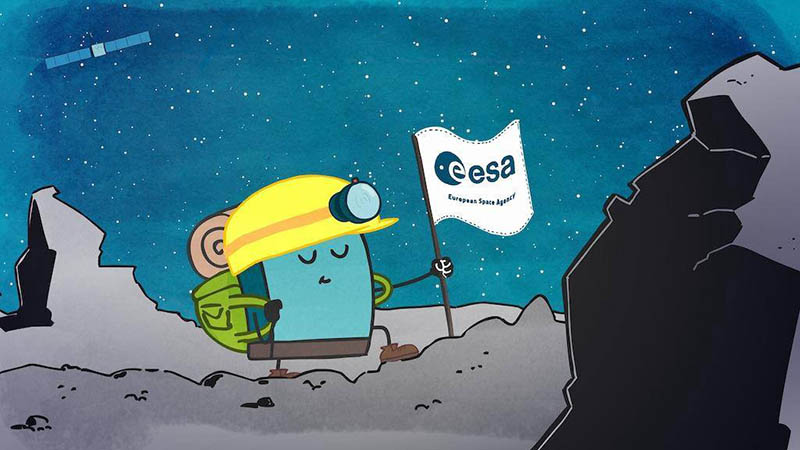
And worse than that. The public often think space is just human spaceflight, completely missing the massive economic value to our economy that it provides. Around 110 000 jobs in the UK are dependent on the space sector, and it generates over £12 billion a year for the economy.
We use space to track crop yields, to tackle illegal fishing in our sea and logging in our forests. We use space to track icebergs in the oceans and to provide disaster management and recovery mapping services. Does investing €90 million in human spaceflight not risk losing the true value of space?
So for a final time, what is the point of human spaceflight?
It’s common for governments to seed new commercial sectors. Commercial robotic spaceflight built on significant government investment. Inmarsat, the space telecommunications company, started as a not-for-profit by the International Maritime Organization, a UN body. It joined the London Stock Exchange’s premier listing, the FTSE-100, in June of this year. The Global Positioning System, GPS, was funded and developed by the US military. By 2011 various estimates place 6–10 % of our GDP as being dependent on it; that is more than €800 billion in the European Union a year. That means if we turn off GPS it will cause a bigger economic downturn than that caused by the recent banking crisis! Space-based Earth observation was funded initially by governments, the global commercial data market was $2.3 billion in 2014 and it is expected to reach $4.5 billion by 2024.
Returning to human spaceflight, it needs to complete its development cycle. We need to seek sustained mastery of human spaceflight, both its technical and political challenges.
It could be argued via the International Space Station and its predecessors, both the US and Russia, and to a lesser extent Europe and Japan, have with regard to the technical challenges of human spaceflight in low-Earth orbit already achieved this to some level. The station has after all been continuously inhabited for over 15 years.
But equally it could be argued that the US, and to some extent Europe and Japan, have failed to move beyond the pioneering phase with regard to the politics of human spaceflight. For example, due to political interference NASA spent four years developing a test tower for a rocket to launch humans into space that they had already cancelled work on. The tower cost $349 million and was moth-balled on completion in 2014. It will cost $700 thousand a year to maintain it in this moth-balled state.
The rationale for human spaceflight has become confused, yet in some regards all spaceflight is already human spaceflight. Without the operations team we would have no spaceflight.
Human spaceflight needs to be in support of robotic spaceflight, not the other way around. Operating a rover on Mars is challenging, flying an aerial vehicle would be even more so. But why have that operations team on Earth? Human spaceflight should be analogous to working on an oil rig or an artic base. At the same time putting a space station in orbit around Mars, or beyond, to support such exploration is a multi-decade challenge that requires a multi-decade vision.
Today we couldn’t move the operations team into space. But, in September of this year the Danish European Space Agency astronaut Andreas Mogensen controlled a robot on Earth from the space station. And, Tim Peake will continue this work during his stay on the station, operating a rover in Stevenage, England.
We need to learn how to live and work in space. But the idea that we need somewhere to go to do this is from another era. We have somewhere, it’s called the International Space Station and it will take at least another decade before we can be confident we understand the effects of the space environment on humans, and how to safely live and work in it.
Reagan was right in his 1984 State of the Union address when he said “space holds enormous potential for commerce today”. A truth that has been borne by the commercial success of robotic spaceflight. But will our politicians be able to gain the sustained mastery of the politics to allow humanity the time to learn how to safely live and work in space? Or, will the next change of government, or even minister bring the next change of priority as it has so often in the past in the space sector and beyond? How can we as a society expect politicians to take a multi-decade perspective when they could be unemployed in five years because we ourselves so often fail to do so?
So what is the future of human spaceflight?
It should be to develop a sustained mastery of the environment. It should be in low-Earth orbit as it provides a convenient harbour.
It should be humans in support of machines, hopefully not always on Earth, with machines doing the dull, the dirty and the dangerous. But of course, don’t forget the wildcard potential of geopolitics…
